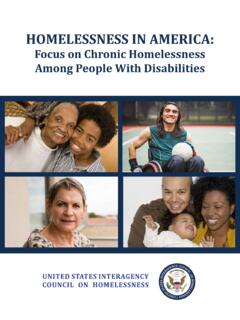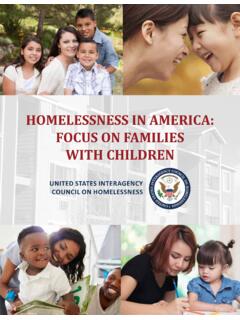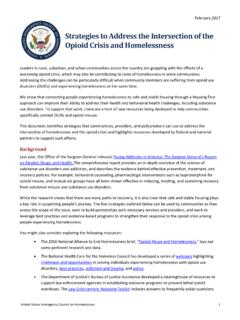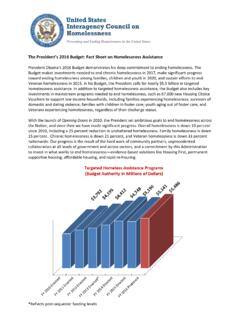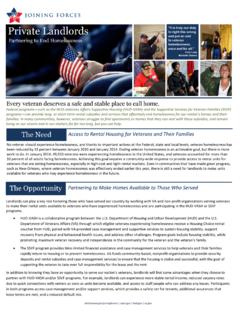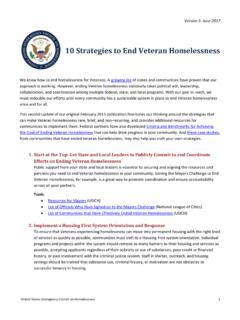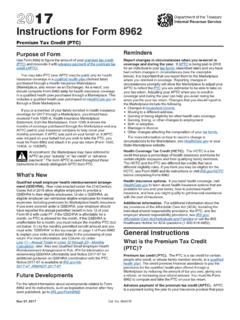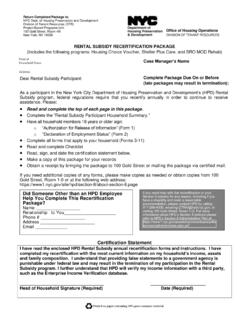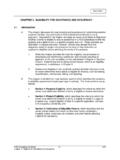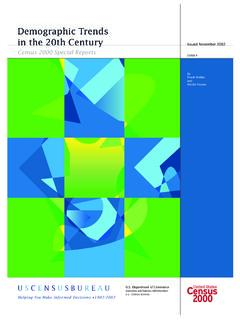Transcription of Homelessness in AmericA: Focus on VeterAns
1 Homelessness in AmericA: Focus on VeterAnsunited stAtes interAgency council on HomelessnessJune 2018 United States Interagency Council on Homelessness 1 Introduction To prevent and end Homelessness in America, we need to have a clear understanding of who is at risk of Homelessness and who experiences Homelessness . We also need to be attentive to differences within and between subpopulations of people who are at-risk or are experiencing Homelessness . In our Homelessness in America series, we are summarizing the most relevant data and research regarding different subpopulations to help inform the work we must do, together, across the federal government, states, and local communities to end Homelessness once and for all. In this Focus on VeterAns brief, we review data and information that help us answer the following questions: What is the scale of Veteran Homelessness ? What do we know about the VeterAns who experience Homelessness ? What do we know about patterns of Homelessness among VeterAns ?
2 What do we know about VeterAns risks for Homelessness ? What are the most significant gaps in available data and our current understanding of VeterAns who experience Homelessness ? Future briefs in this series will Focus on unaccompanied youth, families with children, individual adults, and people experiencing chronic Homelessness . What is the scale of Veteran Homelessness ? Just over 9% of all adults experiencing Homelessness in the United States are VeterAns of the military. That means that on any given day, an estimated 40,056 VeterAns experience Homelessness in America, according to Point-in-Time counts conducted in January 2017 by communities across the country. Of that estimated number, two-thirds (24,690) were staying in shelters or transitional housing programs, while the other one-third (15,366) were unsheltered, living in cars, in encampments, or on the streets. And while there are VeterAns experiencing Homelessness in every state, nearly one-third reside in just two states, California ( ) and Florida ( ), according to PIT estimates.
3 Over the course of FY 2016, Homelessness services programs across America provided emergency shelter or transitional housing to 124,709 VeterAns , according to HUD s Homeless Management Information System (HMIS) data. In addition, the Department of VeterAns Affairs Supportive Services for Veteran Families (SSVF) program, which provides rapid re-housing assistance, served 67,581 VeterAns in FY 2016. The federal government also funds nearly 90,000 permanent supportive housing opportunities dedicated to VeterAns and their family members through the HUD-VASH program. Through a concerted effort at the federal, state, and local level to increase opportunities for VeterAns to access permanent housing, the number of VeterAns experiencing Homelessness in America on any given day was reduced by an estimated 46% between 2010 and 2017. During that same timeframe, the number of VeterAns experiencing unsheltered Homelessness was reduced by an estimated 50%. June 2018 United States Interagency Council on Homelessness 2 What do we know about the VeterAns who experience Homelessness ?
4 Information regarding the demographic characteristics of VeterAns who experience Homelessness comes primarily from data about sheltered Homelessness obtained from HMIS, as reported in HUD s Annual Homeless Assessment Report to Congress. Gender representation: Most VeterAns who experience Homelessness are men over age 50 living in urban areas. Among VeterAns experiencing sheltered Homelessness in 2016, about 9 in 10 (91%) were men, about the same as for all Women make up about 9% of VeterAns who were experiencing Homelessness during 2016, and women also make up about 9% of the overall Veteran population in the While the number of Veteran women in the has increased significantly in recent years, the number of women VeterAns experiencing sheltered Homelessness in 2016 was about the same as in 2009. Veteran women are more than twice as likely as non-Veteran women to experience The characteristics of Veteran women who experience Homelessness are different from Veteran men.
5 More than one third of Veteran women who experience Homelessness have experienced military sexual trauma, and they have lower rates of substance abuse and mental health problems than Veteran men who experience Homelessness . Women make up more than 15% of all active duty members of the armed forces, and are expected to be about 12% of the nation s VeterAns by 2025. With this increase, it is likely that there will be an increasing number of women VeterAns who are experiencing or at risk of Homelessness in the coming household composition: Less than 3% of VeterAns experiencing Homelessness ( ) were in families with children. Veteran women experiencing Homelessness are more likely to be a part of a family with children, compared to Veteran men. Of the 67,581 VeterAns served through the Supportive Services for Veteran Families Rapid Re-Housing program, were in households with The average household size was people. Representation of older adults: Nearly 6 out of 10 ( ) VeterAns experiencing sheltered Homelessness in 2016 were age 51 or older, and the number of elderly VeterAns (age 62 and older) experiencing Homelessness increased between 2009 and More than half of all VeterAns who accessed a VA specialized homeless 1 Department of Housing and Urban Development.
6 (December 2017) The 2016 Annual Homeless Assessment Report (AHAR) to Congress Part 2 2 Department of VeterAns Affairs National Center on Homelessness Among VeterAns (July 2016). Homeless Evidence & Research Roundtable Series: Women VeterAns and Homelessness . Accessed at: 3 Byrne, T. (August 2016). Department of VeterAns Affairs National Center on Homelessness Among VeterAns Research Brief: Emerging Populations: Female, OEF/OIF/OND, and Older VeterAns 4 Department of VeterAns Affairs. Supportive Services for VeterAns Families (SSVF) FY 2016 Annual Report 5 2016 AHAR part 2 June 2018 United States Interagency Council on Homelessness 3 program or were identified as experiencing Homelessness when they accessed VA health care in 2015 were aged 55 and Older VeterAns are expected to be a majority of the population of VeterAns who experience or are at risk of Homelessness in the coming years. As members of this group get older, they are likely to have increasingly complex and age-related needs.
7 Among participants in the VA s transitional housing programs, a significantly greater proportion of VeterAns age 55 or older have serious medical problems, compared to younger VeterAns , making them especially vulnerable to experiencing negative consequences related to Operation Enduring Freedom (OEF), Operation Iraqi Freedom (OIF), and Operation New Dawn (OND) VeterAns : Compared to the number of older VeterAns , those who served in the recent conflicts in Iraq and Afghanistan, who are part of the larger cohort of VeterAns who have served in the post-9/11 era, make up a relatively small but growing number of VeterAns experiencing or at risk of Homelessness . This group of VeterAns is more racially diverse than older VeterAns , and includes more women. Post 9/11 VeterAns have a higher rate of service-connected disability, and they are more likely to receive public assistance and have lower incomes, compared to older VeterAns . There is some evidence that behavioral health needs among those who experience Homelessness in this group of VeterAns are different from the needs of older VeterAns , including higher rates of Post-Traumatic Stress Disorder (PTSD) and lower rates of substance use and other mental health Racial demographics: VeterAns experiencing sheltered Homelessness were times more likely to identify as African American or Black, compared to all VeterAns ( vs.)
8 In 2016. Nationwide, only about one in five ( ) VeterAns identified as belonging to groups other than white, or as white and Hispanic, but about half of all VeterAns experiencing Homelessness ( ) and nearly two-thirds of VeterAns experiencing sheltered Homelessness in families with children ( ) identified as such. Among Veteran women receiving VA health care services who were screened for housing instability or Homelessness between 2013 and 2016, women who had some indicator of housing instability were much more likely to be African American compared to women VeterAns who were stably housed (41% vs. 26%).9 Disabilities and chronic health conditions: A majority (55%) of VeterAns experiencing sheltered Homelessness had a Among VeterAns experiencing Homelessness who received health care services from the VA, more 6 Byrne, T. (August 2016). Emerging Populations: Female, OEF/OIF/OND, and Older VeterAns .
9 7 Brown, , Barnett, , Frahm, , Schinka, , Schonfeld. L., Casey, R. J. (January 2015) Health Risk Factors and Differences in Outcomes Between Younger and Older VeterAns Using VA Transitional Housing Psychiatric Services, 66(1), 33-40 Accessed at 8 Byrne, T. (August 2016). Emerging Populations: Female, OEF/OIF/OND, and Older VeterAns . 9 Szymkowiak, D & Montgomery, (February 2018). VA National Center on Homelessness Among VeterAns Research Brief: Housing Instability among Women VeterAns Accessing Care through the VeterAns Health Administration. 10 2016 AHAR part 2 June 2018 United States Interagency Council on Homelessness 4 than one in four (28%) received diagnoses of chronic medical conditions, more than one in four (28%) received a diagnosis of depression, one in eight (13%) received a diagnosis of PTSD, about one in five (19%) received a diagnosis of alcohol abuse, and about one in five (20%) received a diagnosis of drug There is not very good data currently available regarding the health services VeterAns receive outside of the VA system.
10 Geographic locations: Three-quarters of VeterAns experiencing sheltered Homelessness ( ) in 2016 were served in principal cities12. In comparison, only about one-third ( ) of VeterAns living in poverty were living in principal cities, and almost one quarter of VeterAns live in rural areas. Evidence suggests that VeterAns in rural areas are less likely than those in urban areas to face literal Homelessness , but they may face greater risk of other housing challenges related to residential mobility or instability and adequacy, availability, affordability, and accessibility of About one out of six VeterAns who have been identified as experiencing Homelessness when they receive services from the VA are living in rural areas. VeterAns who experience Homelessness in rural areas are much more likely to be white, compared to VeterAns in urban or suburban areas. Among people experiencing Homelessness who are served by the VA, rates of diagnoses for depression, PTSD, and substance use disorders are higher for rural VeterAns compared to those living in non-rural VeterAns in rural areas who experience Homelessness have lower rates of participation in most VA homeless service programs that provide housing assistance or other specialized services, and they often travel to more urban areas to access assistance from VA homeless programs.
